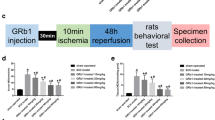Abstract
In order to explore whether the apoptosis in ischemia–reperfusion injury could be affected by Ginkgo biloba extract (GBE) and the free radical scavenger GBE could suppress this affection. Rabbits were randomly divided into sham group, ischemia group, ischemia–reperfusion group (1, 6, 24, 48 h), the drug group (1, 6, 24, 48 h). Measure the rate of apoptosis by flow cytometry, the caspase 9 and apoptosis-inducing factor (AIF) in the cytoplasm and serum by ELISA. Compared with the sham group and ischemia group, the reperfusion group increased the rate of apoptosis, the caspase 9 and AIF in serum have a peak at 24 h after reperfusion, in the cytoplasm the peak at 6 h.GBE inhibit performance has the systemic and local aspects. The apoptosis of nerve cells after spinal cord ischemia–reperfusion has the relationship with the mitochondrial caspase-dependent and caspase-independent pathways and both the local and systemic role. GBE inhibits nerve cell apoptosis by these ways.

Similar content being viewed by others
References
Chandrasekaran K, Mehrabian Z et al (2003) Neuroprotective effects of bilobalide, a component of Ginkgo biloba extract (EGB761) in global brain ischemia and in excitotoxicity-induced neuronal death. Pharmacopsychiatry 36(Suppl 1):S89–S94
De Girolami U, Zivin JA (1982) Neuropathology of experimental spinal cord ischemia in the rabbit. J Neuropathol Exp Neurol 141:129–149
Fan LH, Wang KZ et al (2006) Effects of Ginkgo biloba extract on lipid peroxidation and apoptosis after spinal cord ischemia/reperfusion in rabbits. Chin J Traumatol 9(2):77–81
Fercakova A, Halat G et al (1992) Graded postischemic reoxygenation reduces lipid peroxidation and reperfusion injury in the rabbit spinal cord. J Brain Res 593:159–167
Gurit JM, Dion RA (2002) State-of-the-art of neuromonitoring for prevention of immediate and delayed paraplegia in thoracic and thoracoabdominal aorta surgery. Ann Thorac Surg 74:S1867–S1869
Haramaki N, Aggrawal S et al (1994) Effects of natural anti-oxidant Ginkgo biloba extract (EGB) on myocardial ischemia-reperfusion injury. J Free Radic Biol Med 16:789–794
Joza N, Susin SA et al (2001) Essential role of the mitochondrial apoptosis-inducing factor in programmed cell death. Nature 410:549–554
Kirsch JR, Helfaer MA et al (1992) Evidence for free radical mechanisms of brain injury resulting from ischemia-reperfusion induced events. J Neurotrauma 9(Suppl 1):157–163
Koeltringer P, Langster W et al (1995) Dose-dependent hemorheology effects and microcirculatory modifications following intravenous administration of Ginkgo biloba special extract EGB761. Clin Hemorheol 15:649–656
Kusmic CGA, Lazzerini G et al (2004) The effect of Ginkgo biloba in isolated ischemic/reperfused rat heart: a link between Vitamin E preservation and prostaglandin biosynthesis. J Cardiovasc Pharmacol 44:356–362
Liu DY, Ye JT et al (2004) Ampelopsin, a small molecule inhibitor of HIV-1 infection targeting HIV entry. Biomed Environ Sci 17:153–164
McKenna LA, Gehrsitz A et al (2000) Effective isolation of high-quality total RNA from human adult articular cartilage. Anal Biochem 286:80–85
Qayumi AK, Janusz MT et al (1994) Additive effect of allopurinol and deferoxamine in the prevention of spinal cord injury caused by aortic crossclamping. J Thorac Cardiovasc Surg 107:1203–1209
Susin SA, Lorenzo HK et al (1999) Molecular characterization of mitochondrial apoptosis-inducing factor. Nature 397:441–446
Ueno T, Furukawa K et al (1994) Spinal cord protection: development of a paraplegia-preventive solution. Ann Thorac Surg 58:116–120
Urbano A, Lakshmanan U et al (2005) AIF suppresses chemical stress-induced apoptosis and maintains the transformed state of tumor cells. EMBO J 24:2815–2826
Wang GX, Cao FL et al (2006) Progress in researches on the pharmaceutical mechanism and clinical application of Ginkgo biloba extract on various kinds of diseases. Chin J Integr Med 12(3):234–239
Westergren H, Farooque M et al (2001) Spinal cord blood flow changes following systemic hypothermia and spinal cord compression injury: an experimental study in the rat using Laser-Doppler flowmetry. Spinal Cord 39:74–84
Zivin JA, De Girolami UJ (1980) Spinal cord infarction: a highly reproducible stroke model. Stroke 11:200–202
Author information
Authors and Affiliations
Corresponding author
Additional information
Weizhuo Wang, Lei Lin, Fengtao Li, and Xin Wang contributed equally to this work.
Rights and permissions
About this article
Cite this article
Cheng, B., Wang, W., Lin, L. et al. The Change of the Spinal Cord Ischemia–Reperfusion Injury in Mitochondrial Passway and the Effect of the Ginkgo biloba Extract’s Preconditioning Intervention. Cell Mol Neurobiol 31, 415–420 (2011). https://doi.org/10.1007/s10571-010-9634-5
Received:
Accepted:
Published:
Issue Date:
DOI: https://doi.org/10.1007/s10571-010-9634-5




